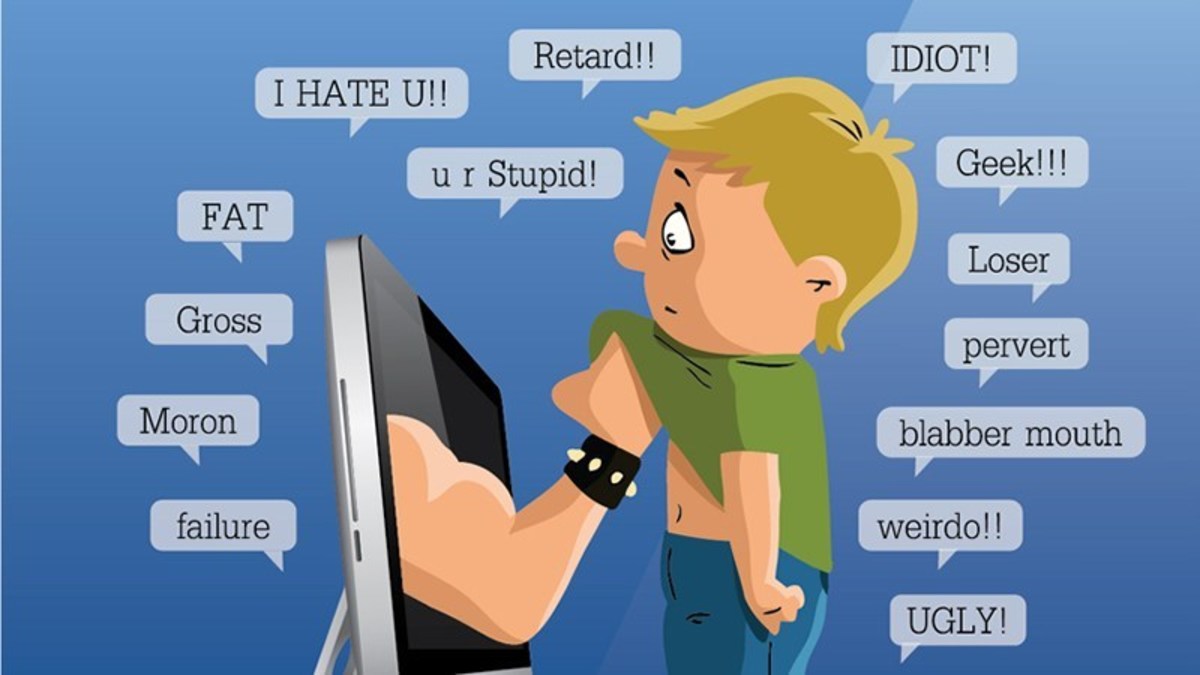The Implications of Cyber Bullying- Part 3

Responsibilities of Teachers & Schools
School administration often struggles to define their role in dealing with cyber bullying, since the acts often happen outside the confines of school suggests Feinberg & Robey (2008, p. 10). While the situation itself occurs away from school, cyber bullying itself “can undermine school climate, interfere with victims’ school functioning, and put some students at risk for serious mental health and safety problems” notes Feinberg and Robey (p. 10). Feinberg and Robey further assert that school administration should take the matter of RA seriously, stating, “Out of site cannot be out of mind. School leaders cannot ignore cyberbullying [sic] but rather must understand its legal and psychological ramifications and work with staff members, students, and parents to stop it” (p. 10). Childnet International (2007) reminds educators that the school should be a safe haven for children, but it cannot be safe when a student is bombarded with acts of RA.
Although many schools have policies regarding traditional bullying, violence, and discrimination, not all schools administrators know how to identify and deal with RA. For example, Juvonen, one of the contributors of the Science Letter article “Behavior; Bullying Among Sixth Graders a Daily Occurrence” (2005) notes
School policies often distinguish among different types of harassment, punishing physical aggression and certain forms of name- calling, such as sexual harassment or racial slurs, while tolerating other insults, Juvonen said. She advocates policies that target all forms of harassment as inappropriate.
‘It's unwise to expect kids to understand that they can't refer to someone's body parts, but can otherwise put them down,’ Juvonen said. ‘Many classrooms have rules about sexual harassment, but not about other forms of verbal bullying. It's a bizarre and confusing message to send to kids that certain insults are OK, and others are not. (¶¶ 22- 23)
Another contributor to the same article notes “We find no support for the idea that verbal harassment is less hurtful in causing emotional distress than physical aggression" (Behavior; Bullying Among Sixth Graders a Daily Occurrence, ¶ 24). Schools would be wise to adopt such a philosophy for the benefit of their student body.
ACE (2010) advises schools to be equally concerned with the aggressor as they are the victim, noting the “the problem lies with pupils who are bullying, not with the bullied child” (p. 1). Schools should consider counseling both parties, but treat each party differently. Ideally, schools should have a plan on how to react to cyber bullying and RA issues within their school. For example, ACE notes that UK schools work under the umbrella of the “Safe to Learn” guidance that helps ensure a bully-free school (p. 3). The aims of “Safe to Learn” includes concepts such as:
· Preventing, reducing, and stopping bullying
· Reacting to reports of bullying in a consistent manner
· Offering support for bullying victims
· Disciplining bullies in a manner that teaches him the severity of the issue
· Reporting all known incidents of bullying (ACE, 2010, pp. 3-4)
Books On Bullying
How Parents Can Help?
Even parents who do all the “right” things — such as reviewing their child’s social media accounts or placing the family computer in a central location — can be unaware their child is a victim of cyber bullying. Stomfay-Stitz and Wheeler (2007) warn parents not to think their filtering software fully protects their child from the world of the Internet (p. 308-J). Plenty of words not triggered by a software filter can still hurt a child; and since many students are more tech savvy than their parents are, the child may be able to disable a filter at each use of the Internet. Parents are sometimes the first authority figure to learn about cyber bullying. Above all else, the Bully OnLine website (2011) reminds parents to not respond, interact or engage with cyber bullies; leave the matter to the school or local authorities. Speaking with the bully or the bully’s parents may make the situation even more difficult, suggests ACE (2010, p. 10).
Once the parent knows about cyber bullying, one of the best things a parent can do is to help their child compile a “bully journal” that records as many incidents of RA as possible. Childnet International (2007) reminds parents “many cyberbullying [sic] incidents can themselves act as evidence” (p. 2). As harmful as it can be for the victim to save cyber messages, the message itself can prove to the local authorities and school board that the student is not making up accusations. ACE (2010) suggests collecting information such as the dates, times, locations, witnesses and events that occurred with each bullying session (p. 5). Include information in the journal such as how the event made the victim feel and how it has affected the victim, as well as how the parent has noticed a change in the victim since the beginning of the incidents.
If possible, ask other people who know about the RA, or have been a part of the electronic forwarding chain, to write up a report on the incident as well, suggests ACE (2010), which can only help back up the victim’s case when delivered to the school or local authorities (pp. 5-6). Print accounts of the harassment from all mediums to include with other details in the bully journal, and submit a formal letter to the school as a record of your complaint (ACE, p. 6)
ACE suggests that the parent express to the authorities their full concern for the mental welfare of their child, and including a statement such as “If this does not stop I am worried that…” along with the bully journal and official complaint (p. 5). ACE further suggests that parents offer ideas and suggestion on what the school can do to help future incidents (p. 9). For example, parents may request the bully to be moved to a different class than their student, or ask that the bully be limited as to how close he can come to the child or limit where he goes on the school campus (ACE, p. 10). Students have a right to attend school without fear of harassment.
Conclusion
Due to the prevalence of electronic technology usage, there will always be a potential for cyber bullying with adolescents. RA and cyber bullying is not a right of passage; it is harmful and degrading and can result in tragic, if not deadly consequences. Schools can help curb the frequency of the problem by integrating character-building activities in the classroom to show students the right way to interact with others. Courses in empathy and respect for others along with mentoring programs further develop students who are less like to engage in RA. Schools and parents should look for the signs of cyber bullying and encourage students to report the problem and not try to handle the problem on their own. Cyber bullying is hurtful and it show be addressed promptly to limit student suffering.
Article Information
This is part 3 in a 3-Part series. Please visit HERE for part 1, HERE for part 2 and HERE for part 3.
References
Behavior; Bullying among sixth graders a daily occurrence. (2005). Science Letter, 162. doi: 821655901
Bloom, A. (2009). The cyberbully girls who hide behind false identity. The Times Educational Supplement : TES,(4860), 9. doi: 1894028121
Bully OnLine. (2011). “Cyberbullying on the internet”.
Childnet International. (2007). Cyberbullying: a whole-school community issue.
Feinberg, T. & Robey, N. (2008). Cyberbullying. Principal Leadership, 9(1), 10-14. doi: 1555016271
Goldstein, S. & Tisak, M. (2010). Adolescents’ social reasoning about relational aggression. Journal of Child and Family Studies. 19(4) 471-482. doi: 2077338021
Gomes, M. (2007). A concept analysis of relational aggression. Journal of Psychiatric & Mental Health Nursing, 14(5), 510-515. Retrieved from EBSCOhost.
Herrenkohl, T., Catalano, R., Hemphill, S., & Toumbourou, J. (2009). Longitudinal examination of physical and relational aggression as precursors to later problem behaviors in adolescents. Violence and Victims, 24(1), 3-19. Retrieved from EBSCOhost.
Megan Meier Foundation. (2011). “Megan meier’s story.”
Remillard, A. & Lamb, S. (2005). Adolescent girls' coping with relational aggression. Sex Roles, 53(3-4), 221-229. doi: 924608391
Schaffner, L. Violence against girls provokes girls' violence: From private injury to public harm. Violence Against Women, 13(12) 1229-1248. doi: 10.1177/1077801207309881
Stomfay-Stitz, A. & Wheeler, E. (2007). Cyberbullying and our middle school girls. Childhood Education, 83(5), 308J-308K. doi: 1295272691
Suffolk Public Schools. (2011). “Mean girls- realities of relational aggression.” Retrieved online on July 7, 2011.
Wade, A. & Beran, T. (2011). Cyberbullying: The new era of bullying. Canadian Journal of School Psychology, 26(1), 44-61. doi: 2333968401
Young, E., Nelson, D., Hottle, A., Warburton, B., & Young, B. (2011). Relational Aggression Among Students. The Education Digest, 76(7), 24-29. doi: 2253484481xs









